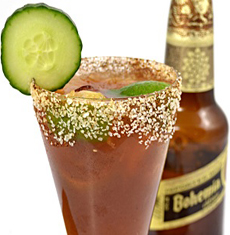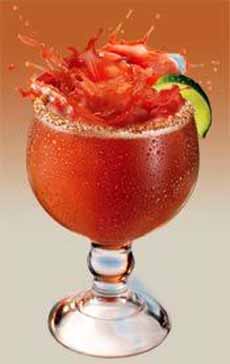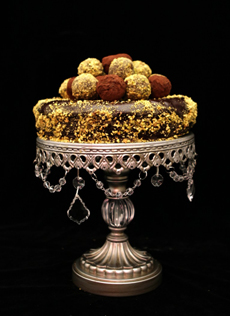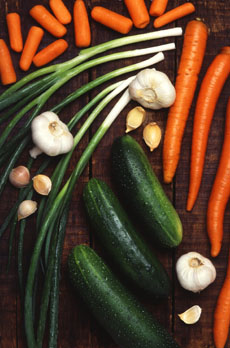|

[1] Tapenade-topped crostini with a garnish of
fresh tomato (photo © Kelly Cline | iStock Photo).
|
|
Here’s an easy tapenade recipe, but first a little story. Back in our college days, a fashionable new restaurant opened in midtown Manhattan. It had a menu that was very exciting for the time.
For starters, instead of serving butter or olive oil with the bread basket, there was an exotic dip: creamy and a bit salty with the flavor of seafood. The bread basket included delicious and sophisticated slices of Melba toast.
We learned in short order that the toasts were called crostini (cruh-STEE-nee) and the dip was tapenade (TAH-pen-odd). They became our favorite hors d’oeuvre for years to come.
In addition to helping us maintain our food-forward-thinker status, tapenade was ridiculously easy to make. Just open three cans or jars, place the contents in the food processor with some seasonings, and pulse.
The recipe for crostini is even easier. Both recipes follow.
Delicious with wine, beer, and cocktails, these recipes are a reason to invite friends and neighbors for a casual get-together. Or make them for Mother’s Day.
|
RECIPE #1: BLACK OLIVE TAPENADE RECIPE (OR ARTICHOKE HEART TAPENADE)
You can substitute green olives for black olives (some people use a half cup of each). If you don’t like anchovies, leave them out. If you don’t like anchovies and tuna, you can substitute artichoke hearts, cooked eggplant, mushrooms, red bell peppers, or sundried tomatoes. This is an easy recipe to customize to your own preferences.
If you don’t like black olives, here’s a recipe for green olive tapenade.
If you want to spare the carbs (crostini), tapenade is also delicious with crudités.
At the table, we serve a plate of crostini with a bowl of tapenade and let guests top their own crostini. For passed hors d’oeuvre or an hors d’oeuvre plate, serve them already topped.
You can serve the crostini plain or with a garnish: chopped tomatoes, a strip of pimento, some fresh herbs, or whatever you have on hand.
Ingredients
1 cup pitted black olives(1)
4 tablespoons capers
1/2 lemon, zested and juiced
1 garlic clove, minced
1 tablespoon olive oil (optional)(2)
1 tuna (5 to 6 ounces), drained
1 can (2 ounces) anchovies, drained
Kosher salt and freshly ground black pepper
Notes
Canned olives are famously bland. If you like a stronger olive flavor, buy better-quality olives in the jar or from an olive bar—although you may need an olive pitter to remove the pits.
We find that the oil in the drained tuna and anchovies is often sufficient. Process the mixture without the added olive oil; then decide if you need it. The added olive oil will give the tapenade a thinner consistency. If you’d like it thinner still, add more olive oil, bit by bit.
RECIPE #2: CROSTINI
Makes about 25 slices.
Ingredients
1 baguette*
2 tablespoons olive oil
Sea salt/kosher salt and freshly ground black pepper, to taste
Preparation
1. PREHEAT the oven to 350°F.
2. SLICE thin baguette slices on the bias.
3. MIX the oil and salt and pepper. Using a pastry brush, lightly coat one side of the bread slices with oil. Place on a cookie sheet and bake until golden brown, about 8 to 10 minutes.
_____________
Because the bread is toasted, you can use day-old baguette. In fact, we typically make crostini whenever we have a leftover loaf.
|
|
THE DIFFERENCE BETWEEN TAPENADE AND PESTO
Pesto is typically based on basil although can use other ingredients, from greens (arugula, spinach) to sundried tomatoes. Tapenade is always based on olives. While pesto can be used as a dip, it is actually a sauce, used to coat other foods. Tapenade is a spread that can be used as a dip.
Pesto
Pesto, the Italian word for pounded, is an uncooked sauce made with fresh basil or other vegetable or fruit, plus olive oil and other ingredients. The sauce originated in Genoa, Italy. The classic pesto alla genovese is made with basil, olive oil, pine nuts, Parmesan and/or pecorino cheese and garlic, plus salt. There are many variations on the original recipe; some use herbs or greens instead of basil (arugula, cilantro, spinach, e.g.) or focus on other ingredients (pumpkin, sweet red pepper).
Tapenade
|
|
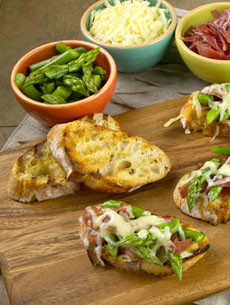
[2] Bruschetta are larger than crostini, and grilled rather than oven-baked (photo © California Asparagus Commission).
|
|
Tapenade is an olive-based spread, typically used as an hors d’œuvre, on crackers or bread. It can be used in recipes as well; for example, to stuff fish fillets. We serve it as a condiment with grilled fish, atop or to the side.
Olives were among the first domesticated crops. Olive pastes and spreads—chopped or ground olives mixed with olive oil—have been served in the Mediterranean region for thousands of years. The “classic” tapenade recipe enjoyed today was invented less than 100 years ago by the chef of the Maison Dorée in Marseilles, who added anchovies and capers to a black olive spread. The word comes from Provençal term for capers, tapéno. Some recipes add tuna as a variation.
And yes, there are olive pestos, that add olives to a traditional pesto—hold the tuna, capers, and anchovies!
As for the tapenade: You can use it to top bruschetta or crostini.
THE DIFFERENCE BETWEEN BRUSCHETTA & CROSTINI
Both bruschetta and crostini are Italian recipes based on toasted bread. The difference is twofold: size and toasting method.
Crostini are small, thin slices cut from a narrow, crusty loaf like a baguette. The word means “little toasts.” They are usually seasoned with olive oil and salt and/or garlic prior to toasting. They can then be topped with a spread or with cheese, meat, seafood, vegetables—often in combination (see photo above).
Bruschetta are typically sliced from a wider crusty loaf and toasted over coals or a grill. The word comes from the Italian bruscare, which means “to roast over coals.” Like crostini, bruschetta can be topped with a wide range of items.
Both will be a welcome addition to your culinary repertoire.
CHECK OUT WHAT’S HAPPENING ON OUR HOME PAGE, THENIBBLE.COM.
|
|
